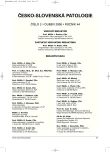Double Immunostaining with CD1a and CD68 in the Phenotypic Characterization of Indeterminate Cell Histiocytosis
Authors:
A. Fernandez-Flores; J. A. Manjon 2; F. Manzarbeitia 3
Authors‘ workplace:
From the Services of 1Anatomic Pathology and 2Dermatology, Hospital El Bierzo, Fuentesnuevas, Ponferrada, Spain, the 1Service of Cellular Pathology, Clinica Ponferrada, Ponferrada, Spain, and the 3Department of Anatomic Pathology, Fundación Jimenez Diaz,
Published in:
Čes.-slov. Patol., 44, 2008, No. 2, p. 37-39
Category:
Original Article
Overview
Indeterminate cell histiocytosis (ICH) is a rare disorder in which histiocytic cells proliferate, expressing markers of both X - and non-X histiocytosis. Nevertheless, it is not totally clear if both types of markers are co-expressed by the same cell in this disorder, or on the contrary, the histiocytosis is made of two phenotypically different types of cells. Some recent reports seem to indicate this latter option, since there is a non-homogeneous distribution of the cells in the dermis. The ones in the most superficial part of the biopsy would lose some of their markers when moving towards the bottom part of the dermis. In order to check if there is co-expression of CD1a and CD68 by the same cell, we performed an immunohistochemical study with double staining, in a case of ICH of a 74-year-old male, who presented multiple yellowish papules in chest, back and both arms. Their sizes varied between 1 and 3 mm.
One of the biopsies from one lesion of the back showed a dermal histiocytic infiltrate, which expressed S-100, CD1a, Factor XIIIa and CD68 in the common immunohistochemical study. Birbeck granules were not found in the ultrastructural study.
Our results with the double stain for CD1a and CD68 demonstrated that most of the histiocytes expressed either one marker or the other. Nevertheless, some of the histiocytes of the infiltrate co-expressed both markers. In all the cases, the cells with this combined phenotype were mononuclear. Although CD1a was mainly expressed by the cells at the top of the dermis, some cells of the deep dermis kept expressing this marker. The cells expressing both markers were mostly found in the top part of the dermis. The multinucleate cells expressed only CD68, but not CD1a.
Key words:
indeterminate cell histiocytosis – Langerhans’ cell – CD1a – CD68 – S-100
Sources
1. Berti, E., Gianotti, R., Alessi, E.: Unusual cutaneous histiocytosis expressing an intermediate immunophenotype between Langerhans cells and dermal macrophages. Arch. Dermatol., 124 : 1250–1253, 1988.
2. Kolde, G., Brocker, E.B.: Multiple skin tumors of indeterminate cells in an adult. J. Am. Acad. Dermatol., 15 : 591-597, 1986.
3. Lessard, R.J., Wolff, K., Winkelmann, R.K.: The disappearance and regeneration of Langerhans cells following epidermal injury. J. Invest. Dermatol., 50 : 171-179, 1968.
4. Murphy, G.F., Bahn, A.K., Harrist, T.J., Mihm, M,C. Jr.: In situ identification of T6-positive cells in normal human dermis by immunoelectron microscopy. Br. J. Dermatol., 108 : 423–431, 1983.
5. Ratzinger, G., Burgdorf, W.H.C., Metze, D., Zelger, B.G., Zelger, B.: Indeterminate cell histiocytosis: fact or fiction? J. Cutan. Pathol., 32 : 552-560, 2003.
6. Rodríguez-Jurado, R., Vidaurri-de la Cruz ,H., Durán-Mckinster, C., Ruíz-Maldonado, R.: Indeterminate cell histiocytosis: clinical and pathologic study in a pediatric patient. Arch. Pathol. Lab. Med., 127 : 748–751, 2003.
7. Romani, G., Schuler, G.: The immunologic properties of epidermal Langerhans cell as a part of the dendritic cell system. Springers. Semin. Immunopathol., 13 : 265–279, 1992.
8. Sidoroff, A., Zelger, B., Steiner, H., Smith, N.: Indeterminate cell histiocytosis - a clinicopathological entity with features of both X - and non-X histiocytosis. Br. J. Dermatol., 134 : 525–532, 1996.
9. Tomaszewski, M.M., Lupton, G.P.: Unusual expression of S-100 protein in histiocytic neoplasms. J. Cutan. Pathol., 25 : 129-135, 1998.
10. Wood, G.S., Hu, C.H., Beckstead, J.H., Turner, R.R., Winkelmann, R.K.: The indeterminate cell proliferative disorder: report of a case manifesting as an unusual cutaneous histiocytosis. J. Dermatol. Surg. Oncol., 11 : 1111–1119, 1985.
Labels
Anatomical pathology Forensic medical examiner ToxicologyArticle was published in
Czecho-Slovak Pathology

2008 Issue 2
Most read in this issue
- Immunohistochemical Detection of TTF-1 in Intraoperative Bioptic Samples of Adenocarcinoma of the Lung: a Year-Long Experience
- Difficulties in Routine Diagnostics of Urothelium Lesions
- Double Immunostaining with CD1a and CD68 in the Phenotypic Characterization of Indeterminate Cell Histiocytosis
- The 2007 World Health Organisation Classification of Tumours of the Central Nervous System, Comparison with 2000 Classification
